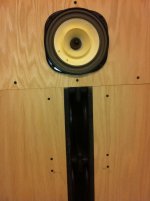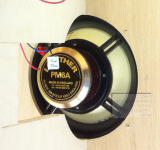PPSL link from diyAudio sub-woofer forum: see below ( post #3)
http://www.diyaudio.com/forums/subwoofers/259780-djk-ppsl-build.html#post4007016
http://www.diyaudio.com/forums/subwoofers/259780-djk-ppsl-build.html#post4007016
...and how well does it match the horn for speed and output level? (I Don't really want to dial back 110db treble and mid sections by a HUGE amount to match a 98db bass section)
Regarding your 135hz horn, and also the 100hz horn. They look deep enough for the frequencies in question, but the mouths looks quite small (<<1/4 wl). What impact does this have on these horns? Is there a lot of mouth ripple? What's the directivity of the horn look like?
...and how well does it match the horn for speed and output level? (I Don't really want to dial back 110db treble and mid sections by a HUGE amount to match a 98db bass section)
If I didn't have the room for a large bass horn (like my spiral bass horn) I'd build a line array of woofers. Line arrays are efficient and only lose 3 db every time you double the listening distance, vs. a point source, which loses 6 d b. If you were to stack eight 10" woofers (12" if you have the ceiling height, or are willing to stagger the speakers a tad), you'd have fast bass response, plenty of power, and a fair amount of SPL per watt.
I fabricated a line array from four 18" woofers and it worked quite well. IMHO, a 10"/12" array won't move quite as much air, but it'll have the speed to keep up with the mid/hf horns.
Regarding your 135hz horn, and also the 100hz horn. They look deep enough for the frequencies in question, but the mouths looks quite small (<<1/4 wl). What impact does this have on these horns? Is there a lot of mouth ripple? What's the directivity of the horn look like?
The little 8", 135 hz horn is incredible. I was listening to them at medium volume (driven by a Dynaco Mk III) in my system the other day. The snare/upper tom drums hit so hard I jumped from my chair. The power and realism is out of this world.
These horns were simmed with Hornresp, and when I attempt to enlarge the mouth, the idea gets shot down. Though the mouths seems small, the performance is spectacular.
BTW, medium volume is a relative term. For me, medium volume is about half of what the system is capable of producing. This would probably be considered quite loud to the average listener.
My friend, who shared the experience with me, broke into laughter midway through the drum solo. I'm sure he's never heard anything like it... 🙂
My friend, who shared the experience with me, broke into laughter midway through the drum solo. I'm sure he's never heard anything like it... 🙂
Carpenter, Once again you have a “I gota build these” design. Your new 135Hz horn looks very intriguing. I am using Tractrix horns also that seem to like to be crossed over around 700 Hz. So the 135Hz horns seem like a perfect match on the high end. On the low end however, what crossover settings do you use between your spiral horns and the 135Hz horns? I am looking at a OD-ML-TL that goes up to ~150Hz and wonder if this will give sufficient overlap?
I remember seeing one at the BAF several years back. It belonged to Nelson Pass, IIRC... it was interesting. Seems to me it made bass and sounded pleasant.
Those are SLOB (slot loaded open baffle) speakers, not PPSL (which have more bandpass action going on)
Carpenter, Once again you have a “I gota build these” design. Your new 135Hz horn looks very intriguing. I am using Tractrix horns also that seem to like to be crossed over around 700 Hz. So the 135Hz horns seem like a perfect match on the high end. On the low end however, what crossover settings do you use between your spiral horns and the 135Hz horns? I am looking at a OD-ML-TL that goes up to ~150Hz and wonder if this will give sufficient overlap?
150 hz offers plenty of overlap (135 hz is the mid bass horns 3 db down). This little, mid bass design is absolutely blowing my mind. It's so crisp, clean, clear (the three Cs). I like this design more than my 100 hz mid bass horn. The problem in the past is that my bass section didn't sound good above 100 hz. With the entrance of the Spiral Bass Horn, that's all changed.
I fabricated my prototype spiral bass horn with the Lab 12 driver in mind. For a customer with deeper pockets than mine 😀 I prefer to use Radian's Neo 2216 driver. The combo makes some pretty spectacular lower mid bass of its own. The point is this: I custom designed/fabricated these 135 mid bass horns for his system (which I'm building top to bottom including the tube amps). Knowing his spiral bass horn coupled to the 2216s meant that I could design a more specialized mid bass horn--one that's more comfortable at its upper crossover than the 100 hz mid bass horn.
I'm not kidding in the least when I tell you that I literally jumped through my skin at the SMACK of that snare drum. It hit so hard, sounded so real that I thought something had blown up, or fallen over.
Those are SLOB (slot loaded open baffle) speakers, not PPSL (which have more bandpass action going on)
Interesting. Bandpass at which particular frequency? Generally I relate bandpass speakers to favoring one note in particular, so I tend to shy away. What's your take?
Those are SLOB (slot loaded open baffle) speakers, not PPSL (which have more bandpass action going on)
Hey!! We both joined DiyAudio in March of 2002! 😀
Hi Carpenter,Interesting. Bandpass at which particular frequency? Generally I relate bandpass speakers to favoring one note in particular, so I tend to shy away. What's your take?
I can't answer your question directly. Let me explain however.
From my understanding (using the terminology described here: Bandpass designs explained - Speakerplans.com Forums )
If the slot port fires into the cavity, you have some series BP6 action . For an example, see this thread . http://www.diyaudio.com/forums/subwoofers/264737-pp-slot-loaded-sub-alpine-swr-12d2.html
If the slot port fires directly into the room, the PPSL operates "SOMEWHAT" like a parallel BP6 design . That said, resonances will be excited at frequencies corresponding to the dimensions of the plenum (a good reason to make the the plenum as small as possible). Additionally (not 100 % sure about this), the plenum acts as a high pass filter to remove higher order frequencies.
In short,
I dont' think PPSL are designed to be one note bandpass wonders. Rahter , they use the concept to "assist" the bass reflex principle with the cone-magnet driver topology further helping to cancel even order distortions.
Hope this post makes sense.
Hey!! We both joined DiyAudio in March of 2002! 😀
... And I see you've have more to show for it since then 🙂 Keep up the good work.
I suggest using a larger throat with a phase plug. I tried it briefly on both Fane S 8M and JBL 2220H that used a 10cm and ~20 cm throat. The biggest difference was with the JBL 2220H where the mids, in my mind, were lifted with 5-10%. The JBL's phaseplug is approx. 40cm long and shaped like a bullet. It does not affect the lower midbass much, but acts like a horn in a horn. Too bad about the poor mid performance of the JBL 2220H, but I still think the concept has potential. If you used a larger throat (10cm?) and a big phase-plug, you would get the sound of the walls of the cone instead of the dust cap. If you are good you could sculpt the plug so that it follows the contour of the cone and dust cap with only millimeters between for more compression, and make it like a large compression driver. The throats total area could be the same as you have now, subtracting the phase plug.
I suggest using a larger throat with a phase plug. I tried it briefly on both Fane S 8M and JBL 2220H that used a 10cm and ~20 cm throat. The biggest difference was with the JBL 2220H where the mids, in my mind, were lifted with 5-10%. The JBL's phaseplug is approx. 40cm long and shaped like a bullet. It does not affect the lower midbass much, but acts like a horn in a horn. Too bad about the poor mid performance of the JBL 2220H, but I still think the concept has potential. If you used a larger throat (10cm?) and a big phase-plug, you would get the sound of the walls of the cone instead of the dust cap. If you are good you could sculpt the plug so that it follows the contour of the cone and dust cap with only millimeters between for more compression, and make it like a large compression driver. The throats total area could be the same as you have now, subtracting the phase plug.
The problems I discovered with creating more compression in front of the cone (by using a sculpted phase plug) are reduced low frequency response and diminished impulse response. I simmed this by reducing the "throat chamber volume" and these (virtual) results are what become of my efforts.
That being said, I find the idea of using a phase plug elegant--sexy too! 🙂 Too bad it doesn't work out in a simulation.
I did not really notice a difference in midbass when trying it. When do it in real life you have the possibilty to move the phase plug until you hit the sweat spot. It is not a drastic difference, especially not on drivers with an already pronounced midrange like the Fane S 8M
- Status
- Not open for further replies.
- Home
- Loudspeakers
- Multi-Way
- Mid-bass horn (easy to build)

